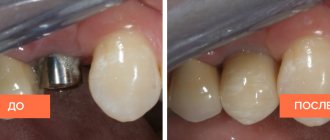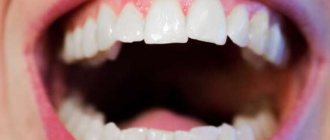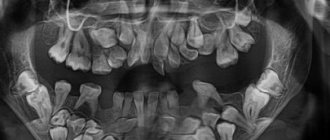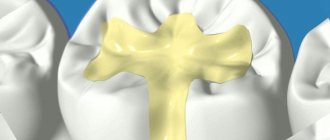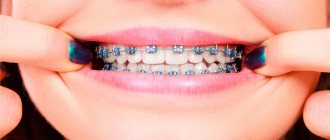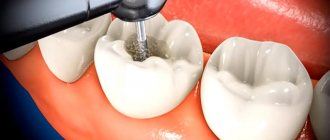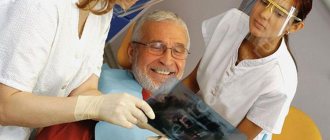The time for dental implantation is determined by several factors:
- Has bone grafting been performed?
- Are there any foci of infection in the oral cavity, and how much work will be required for treatment;
- What method is the surgery planned for?
In addition, the patient will have to undergo tests, have an X-ray and CT scan, and, if necessary, undergo treatment for other non-dental diseases if they are a contraindication for implantation.
How long does it take to insert a tooth?
The duration of the tooth restoration procedure depends on the restoration method. If the tooth is destroyed by no more than 1/3 and has a intact root, it can be restored directly in the patient’s mouth in one visit. If the root is preserved and the crown part of the tooth is destroyed by more than 1/3, you can resort to microprosthetics, which is also performed in one visit.
If the coronal part is significantly destroyed and the tooth must be removed, implantation or installation of a bridge structure supported by adjacent teeth is indicated. If the patient chooses implantation, then modern protocols make it possible to restore the integrity of the jaw row in one or two visits. The traditional protocol involves allowing the implant to heal for about six months and, if osseointegration is successful, installing a permanent crown.
Diagnostics
Diagnostics is a mandatory procedure in the therapeutic stage of preparation for prosthetics.
Its purpose is to determine the quality and thickness of the jaw bone, the condition of dental roots and canals, identify pathologies that occur in a latent form, and study the features of the bottom of the maxillary sinus and maxillary sinuses.
The results of diagnostic examinations are needed to determine the indications (limitations) for prosthetics, choose the method of tooth restoration and the type of prosthetic structure.
Thanks to a comprehensive study of the dental system, it is possible to prevent complications and extend the life of the prosthesis.
Today the therapeutic stage practices the following types of research:
- CT scan (CT).
An informative diagnostic method that allows you to obtain an accurate three-dimensional image of the patient’s dentoalveolar apparatus, by which the doctor can identify hidden anomalies, assess the condition of the alveoli, check the quality of the jaw bone, and determine root defects.The image is clear enough and can be viewed in all projections and enlarged (if necessary), which has a positive effect on the accuracy of drawing up a treatment plan.
The average duration of a scan is no more than 10 seconds, plus you need to add time for the doctor to draw up a card, prepare for the procedure, position the device, and print out the result.
Computed tomography is convenient for that category of people who have permanent metal prosthetic structures.
- Orthopantomogram.
This is one of the common types of x-ray examination, otherwise known as a panoramic image (with two-dimensional visualization).The orthopantomogram shows a clear picture of the condition of the entire dentofacial apparatus, i.e. Using the image, you can not only study the condition of all remaining teeth, the temporal joint and the jaw bone (its density and volume), but also determine the distance to the maxillary sinuses, consider their condition and location.
A panoramic image also helps to create a correct and competent treatment plan. The duration of the diagnosis is no more than 15 minutes, the image is taken within 5 minutes.
- MRI (Magnetic resonance imaging).
A diagnostic method used to determine the presence of hidden pathologies of the dental system, determining the quality and condition of tissues.Among the advantages is the ability to obtain a clear 3D image without distortions and errors with increased contrast, which allows you to study in detail the area of the proposed restoration. The average duration of the examination is about half an hour.
- Radiovisiography.
This is an X-ray diagnosis of the condition of the dental system, displaying the result on several or one targeted image.They are used both for the study of a single dental element and its roots, and for diagnosing the condition of the periodontal tissues and jaw bone. The approximate duration of the process is 7-10 seconds.
Important! The doctor decides which diagnostic method will be prescribed, based on the characteristics of the clinical case and the scope of the upcoming treatment.
It is impossible to accurately indicate the duration of the clinical stage - it all depends on the age of the patient, his state of health and the duration of obtaining the result, i.e. from 1 day to 10 days (if you wait for the result for HIV infection).
How does the second stage of dental implantation proceed?
The second stage of dental implantation is marked by the installation of a gum former. The purpose of the implant system element is to create a beautiful contour of the gum line. With one-stage implantation, the former is installed immediately after implantation. The construction is removed at the second visit and replaced with a temporary crown on the abutment. With a traditional two-stage protocol, the former is installed only after 4-6 months, when the implant has successfully taken root. In this case, a second operation is performed, during which the gingival flap is excised, the plug is removed from the implant, the former is fixed, and the wound is sutured tightly.
Why do all stages take several months?
With classical implantation, from the moment of implantation to the installation of the crown, some time is necessary for osseointegration - there must be contact between the bone tissue and the implant. The relationship is achieved due to the overgrowth of the rod with the bone tissues of the jaw, which contributes to successful implantation.
Implants in the upper jaw take 5-9 months to osseointegrate . On the bottom - within 3-5 months. The difference in timing is due to lower bone density in the upper jaw and reduced load on it.
After healing, a gum former is placed, then an abutment. Tissue healing at this stage, on average, ranges from two weeks to one month.
The final stage is the installation of a crown, which takes from one to three weeks to complete.
How long can you wear implants without crowns?
If we consider a two-stage implantation protocol, then you will have to walk without permanent crowns for six months. To restore the aesthetics and chewing function of the dental system, temporary plastic crowns are fixed 2-3 months after surgery.
Permanent crowns are installed only after successful osseointegration of the implant into the bone tissue. Temporary crowns should be worn not only for aesthetics, but also to prevent atrophy of the bone tissue of the jaw arch and destabilization of the titanium rod.
How long does the installation operation take?
Integration of the implant does not take much time. For simultaneous implantation - 15-20 minutes (excluding the time for tooth extraction). With classic implantation, it takes about 50 minutes, sometimes an hour.
The qualifications and experience of the doctor are of great importance. The more experienced the surgeon, the faster and more accurately the dental structure will be installed.
How to install an implant using the classical method, stages of the operation:
- Preparation of bone tissue . The gum is cut and peeled away, and the exposed portion of the bone is prepared.
- Formation of the bed . A narrow channel is drilled, which is gradually expanded with drills. The width of each subsequent drill should be increased by 0.5 mm. Afterwards, a thread identical to the implant thread is cut.
- Screwing in the implant . The rod is fixed to a special tool and screwed into the bone. Then stitches are placed on the gum.
What happens if the implant does not take root?
Implant failure is difficult to prevent. The causes of the pathology may be peri-implantitis, smoking, non-compliance with medical recommendations in the early and late postoperative period. If acute rejection occurs, removal of the titanium rod is indicated. Re-implantation is possible only after complete healing of the wound. Rejection can develop several years after the permanent crown is installed. A number of external and internal factors can provoke a pathological process and destabilization of the implant.
Advantages of using innovative technologies
Dentistry has been actively developing and undergoing significant changes in recent years. Innovative technologies have become available to patients, making the process of dental restoration safer, faster, more reliable, more comfortable and of higher quality.
Such technologies include:
- CAD/CAM system. This is an abbreviated name for modern computer technology: where CAD - Computer-Aided Design - means design using computer programs, CAM - Computer-Aided Manufacture - production using computer technology.
The system makes it possible to automate all stages of the manufacturing process of an orthopedic structure. - Three-dimensional prosthetics (3D). It involves the inclusion of high-precision computer technologies in all stages of prosthetics, starting from diagnosing the condition of the dental system, ending with the development and creation of a prosthesis.
- CEREC system. This is a computer technology, the peculiarity of which is the production of a prosthetic structure directly in front of the patient’s eyes, i.e. in one visit to the clinic.
- Nobel Procera . Computer technology makes it possible to produce biocompatible, high-precision, ideal in functionality and aesthetics, durable prostheses.
The demand for new technologies in dental prosthetics is constantly growing. Their popularity is explained by a number of significant advantages:
- The patient's time is saved, i.e. The duration of the entire recovery process and the number of planned visits to the doctor are reduced.
- Cash costs are reduced due to the absence of payment for performing bone grafting in case of insufficient jaw bone volume and a reduction in clinic visits.
- The rehabilitation period is shortened and easier.
- There are no risks of complications associated with inaccurate fit, unnecessary trauma, damage to nerves and the maxillary sinus.
- The end result can be visualized, i.e. The patient can view the progress of prosthetics on the computer and see the result.
- Based on the complexity of the case, you can select the optimal prosthesis model or accurately determine the safe place for inserting the implant.
- Tissue trauma is minimal.
- Automation of the manufacturing process of prosthetic structures helps make them accurate and comfortable.
- The human factor is excluded.
Cost of instant implantation
Below is a table with the prices of some dental clinics where you can get your teeth done in one day in Moscow.
| Clinic | All-on-4 | All-on-6 |
| Implant Expert | from 200,000 rub. | from 250,000 rub. |
| D Studio | from 179,000 rub. | from 249,000 rub. |
| Akademstom | from 110,000 rub. | from 170,000 rub. |
| New white smile | from 145,000 rub. | from 185 00 rub. |
| Novadent | from 189,000 rub. | from 276,000 rub. |
How to choose a specialist
The first thing you should pay attention to is the availability of diagnostic equipment in dentistry. If you were sent to another clinic for a CT scan of your teeth and oral cavity, you should think twice. Modern equipment should be in every serious medical center.
Second, no less important, is the doctor’s experience in the field of implantology. Due to the complexity of the process, the specialist must have experience in performing the operation in this particular direction. Before your consultation, try to educate yourself about the different methods of immediate loading implantation and ask enough questions to the specialist to assess his level of professionalism.
How to behave before and after surgery to install a dental implant? Memo.
Despite all the harmlessness, installing an implant is still an operation. Even when treating common caries, many patients, as soon as they sit down in the dentist’s chair, already dream of jumping out of it as quickly as possible, forgetting their things and everything in the world, just to quickly find themselves outside the walls of the office. This is instead of asking in detail and remembering how to behave after a date with the dentist. Therefore, if the surgeon did not bother to hand over a reminder sheet in advance, then already at home the questions begin: “what to do with this happiness now?” Is it possible to eat, drink, smoke, brush your teeth around the wound, etc. But let's start in order.
What to do before dental implantation?
— a couple of hours before the operation it is worth eating a little (if the operation is in the morning, a light breakfast with sweet tea, if in the afternoon, a light lunch instead of a 3-course dinner). It is strictly not recommended to come to your appointment hungry, so as not to faint even at the stage of “freezing” the operation area. Of course, no one feels sorry for ammonia, and it’s not very possible to actually fall while lying on a chair. But still, there is no need to irritate the medical staff once again.
- if you consider yourself to be a “nervous” type of patient, you are afraid of everything, you are terribly nervous about any medical issue, then it would not be amiss to take something sedative, at least a banal “valerian”, at least 30-40 minutes before the “X” hour form. Never relieve tension before surgery with alcohol. In especially severe cases, you should consult your doctor about taking stronger sedatives. Or, as an option, discuss with the surgeon the possibility of performing the operation under sedation (i.e. in a semi-conscious state under the influence of special anesthetic drugs). Of course, if you are impressionable, then you should not look at photographs and videos of “live” operations on the eve of the operation. On the contrary, you should be as distracted as possible, get a good night’s sleep, so that you can come to your doctor’s appointment in a cheerful and cheerful mood.
- in some cases, shortly before the day of surgery, you should start taking antibiotics and antihistamines (to reduce postoperative discomfort). This is not always necessary, and your surgeon should tell you about this in advance.
- Immediately before your appointment, it is advisable to brush your teeth well. You shouldn’t take up the surgeon’s time to do this for you.
What to do after dental implantation?
— immediately after the operation you should take 1 painkiller tablet, and another 1 at night. Other medications (antibiotics, antihistamines) are at the discretion of the doctor. Not in all cases their use is necessary. I would even say that mostly they are not needed.
— if possible, in the first hours after surgery, cold should be applied externally to the injured area. This will significantly reduce the likelihood of swelling and bruising.
— try not to drive immediately after surgery, and not to plan any work that requires increased attention.
— the first few days after surgery, you should avoid serious physical activity, hypothermia, overheating (bath, sauna, hot bath).
— try to carefully observe oral hygiene, but use a toothbrush in the operation area without fanaticism. Despite the fact that during implantation, the surgical wound is almost always sutured and it is quite difficult to damage anything, nevertheless, you need to be very careful. In addition to standard brushing of teeth, it is worth rinsing your mouth with weak antiseptics, for example, a 0.05% chlorhexidine solution for the first few days. Keep in mind that prolonged use of this drug results in the appearance of a grayish-brownish plaque on the teeth, which, however, can be removed later without much difficulty. In the first 3-4 days after brushing and rinsing your teeth, it is good to lubricate the gums at the operation site with an ointment that accelerates its healing (for example, Solcoseryl dental adhesive paste or Asepta adhesive balm).
— try to choose a more gentle diet without rough solid food for the first few days.
- to prevent swelling, try not to sleep at night on the side where the operation was performed for the first couple of days. It is also worth being in an upright position more, sitting and lying down less. Try to keep your head higher than the rest of your body.
- do not forget that usually after 7-10 days you need to go to the doctor for an examination and removal of stitches.
— in any circumstances, you should not independently inspect the surgical site using your fingers, toothpicks and other improvised means.
In these cases, you should call your doctor or show up for an unscheduled examination:
- If after 2-3 days the pain in the implantation area does not go away, if there are signs of an increase in throbbing acute pain, sharp pain when touching the operation site with the tongue.
- If you continue to bleed several hours after surgery
— If after a few hours the feeling of numbness in the surgical area does not completely go away (especially for cases of installation of implants in the lower jaw).
Stages of treatment
Implantation in 1 day is prosthetics immediately after the installation of implants. The issue of aesthetic and practical function of teeth is resolved in a short time. This operation does not require bone grafting. Implants can be installed not only in the spongy substance, but also in deeper layers of bone. In addition, the pins can be placed at an angle. This technology allows you to avoid injury to nerves, blood vessels and paranasal sinuses.
The installation of implants is carried out in one visit to the dentist, but to achieve the final result, this procedure requires preparatory measures. The whole operation takes place in several stages:
- At the first session, the doctor conducts diagnostics, determines the current condition of the patient’s teeth, possible contraindications, and performs a computed tomography scan. If preliminary treatment is necessary, it must be carried out. Otherwise, it will not be possible to install new teeth. At the same appointment, a model of future prostheses is created. The waiting period for future implants ranges from 1 to 7 days. Next, the doctor chooses the method of performing the procedure, selects the pins and makes the crowns that will be installed.
- The second stage is the work of installing the metal pins themselves. It is performed under anesthesia in one procedure. At the site where the implants are installed, an incision is made in the gum and pins are screwed into the prepared recess. Then the gum is sutured. Next, a temporary prosthesis is placed on the implanted implants. It is made of acrylic, so it is quite light, which contributes to comfortable wear and rapid healing.
The permanent prosthesis is installed 6-12 months after implantation. This time is enough for the implant to fuse with the bone.
Service life and guarantees of the clinic
The service life of the implant depends on the professionalism of the doctor and the behavior of the patient. If you follow the implantologist’s recommendations and use them correctly, the implant will last a lifetime, and the dentures will last up to 20 years.
ROOTT system implants come with a lifetime warranty. The conditions are valid only if the patient follows the rules of oral care. If the implant fails before installing a permanent denture, the titanium root is reinstalled free of charge.
Mandatory monthly check-ups are required for 12 months after surgery. The results are saved in the patient's service book. If the client ignores these requirements, there are no warranty periods.
Be sure to take time for professional oral hygiene. It is shown at least once a year. When a full jaw is implanted in the clinic, the procedure is free of charge.
Contraindications
- Early childhood and adolescence
- Blood diseases in which clotting is impaired
- Severe uncontrolled diabetes mellitus
- Advanced tuberculosis
- Severe osteoporosis
- Serious endocrine disorders
- Oncological processes in the acute stage
- Intolerance to anesthetic drugs
- Serious central nervous system disorders
- Chronic alcoholism, drug addiction
- The patient does not follow the recommendations for care
Temporary contraindications to surgical intervention are the unsatisfactory condition of the gums and enamel, pregnancy, periods of exacerbation of chronic diseases, colds and flu.
Thanks to the development of technology, the installation of dental implants has become available to patients with hepatitis and diabetes, and people with reduced immunity. When using low-traumatic techniques, the procedure is allowed for elderly patients.
What is a surgical guide for implantation? Why is he married? Is it included in the cost of the operation?
A surgical template is a special device for the correct installation of implants, which is usually made by an orthopedic dentist at the stage of planning the operation. In fact, the task of any surgeon performing an implantation operation comes down to the correct protocol installation of the “screw”. But an implant is not an end in itself, it is only an intermediate stage of prosthetics. Those. The implant placed by the surgeon still needs to be somehow fitted with a crown or some other structure. And here it is very important that the implant not only “grows” to the bone, but also stands correctly. What does right mean? In the right place, with the right slope, at the right depth... i.e. it should not just be placed “by eye” of the implantologist, but oriented in a certain way. Because later it may turn out that the implantologist has his own “eye”, and the prosthetist has his own. So, just so that both doctors, working together for a single result, understand each other, a template is necessary. It most often looks like a removable denture.
This is what one of the surgical template options looks like. During the operation, the implantologist will position it in exactly the same way and will no longer be able to place the implant crookedly and in the wrong place where the orthopedist needs it.
To make it, the prosthetist must take impressions in advance and clearly plan the position of future crowns, so that later it does not turn out that the implants are in the wrong place. This is especially important when carrying out large operations, when a large number of implants are placed, and the surgeon does not have any landmarks in the form of neighboring teeth. It is also very important to have a template in anterior surgeries when it comes to achieving maximum aesthetics. If there is a template, the surgeon will apply it to the surgical area during the operation, and then there will be no need to guess how exactly to orient the implant in 3-dimensional space.
A surgical template, as a rule, is not included in the cost of the operation, since, despite everything written above, it is not needed in 100% of cases.
And now I want to show a clear example of what results can be obtained without planning the installation of implants.
This photo shows the sad result of illiterate installation of implants. A young girl lost her front teeth due to injury and the surgeon decided to give her implants without planning treatment with an orthopedist. Just a couple of weeks after the prosthetics, the patient realized that with such teeth she could not smile normally. The result of the treatment was absolutely disastrous from an aesthetics point of view, although both implants took root well.
The reasons for this result are clearly visible here. The implants were placed according to the scheme “like the surgeon’s right hand itching.” They are installed at different angles, at different depths, without taking into account the need to form the correct gingival contour. In this case, an implant system was used, which has limitations in the possibilities of prosthetics, so it is impossible to correct the situation with crowns. Unfortunately, in this case, the only option to fix everything is removal of the implants, bone grafting and re-implantation.
After removal of the implants, the patient was given a banal temporary removable denture (the so-called “bird”), the aesthetics of which are much better than the previously installed crowns on implants.
Cost of implant installation
Patients of the ROOTT clinic are offered a turnkey payment system for each service. Each package includes all necessary manipulations and materials. The cost of installing implants includes:
- implantation system;
- surgery;
- adaptive prosthetics for one-stage protocols;
- preventive examinations during the period of osseointegration.
Bone grafting, sinus lifting, permanent prosthetics after implant healing are paid separately. You can find out more about pricing here.
It is possible to pay in stages and apply for a loan for dental treatment.
